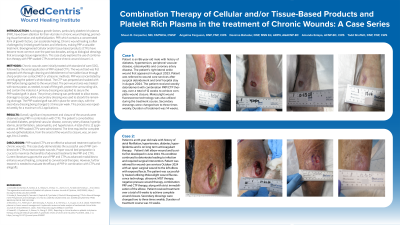Case Series/Study
(CS-023) Combination Therapy of Cellular And/or Tissue-based Products and Platelet-rich Plasma in the Treatment of Chronic Wounds: A Case Series

Autologous growth factors, particularly platelet-rich plasma (PRP), have drawn attention for their vital role in chronic wound healing, promoting tissue formation and epithelialization. PRP, which contains a concentrated form of growth factors, can accelerate healing. Chronic wound healing is often challenged by limited growth factors and infections, making PRP a valuable treatment. Bioengineered Cellular and/or tissue-based products (CTPs) have become more common over the past two decades, acting as biological dressings that encourage tissue regeneration. This case study explores the use of combination therapy with PRP-soaked CTPs to enhance chronic wound closure.1-4
Methods:
Chronic wounds were initially treated with standard of care (SOC), followed by the serial application of PRP-soaked CTPs. The wound bed was first prepped with thorough cleaning and debridement of nonviable tissue through sharp and/or non-contact MIST or ultrasonic methods. PRP was concentrated by centrifuging the patient's whole blood. The CTP was prepared and soaked with PRP before being applied to the wound bed. The peri-wound area was treated with stoma paste, as needed, to seal off the graft, protect the surrounding skin, and contain the material. A primary dressing was applied to secure the PRP-soaked graft in place. The primary dressing was perforated to allow excess drainage to escape, while a secondary dressing was used to absorb the remaining drainage. The PRP-soaked graft was left in place for seven days, with the secondary dressing being changed 2-3 times per week. This process was repeated weekly for a maximum of 12 applications.
Results:
Overall, significant improvement and closure of the wounds were observed using PRP in combination with CTPs. The patient's comorbidities included diabetes, peripheral vascular disease, coronary artery disease, hyperlipidemia, atrial fibrillation, osteomyelitis, and hypertension. A total of 8 to 12 applications of PRP-soaked CTPs were administered. The time required for complete wound epithelialization, from the onset of the wound to closure, was, on average, 8 to 12 weeks.
Discussion:
PRP-soaked CTPs are an effective advanced treatment option for chronic wounds. This case study demonstrates the successful use of PRP combined with CTPs to treat complex wounds. Proper wound bed preparation is crucial to maximize the benefits of advanced treatments like PRP and CTPs. Current literature supports the use of PRP and CTPs as advanced modalities to enhance wound healing, compared to conventional therapies. However, further research is needed to evaluate the efficacy of PRP in combination with CTPs and allografts.

.jpg)